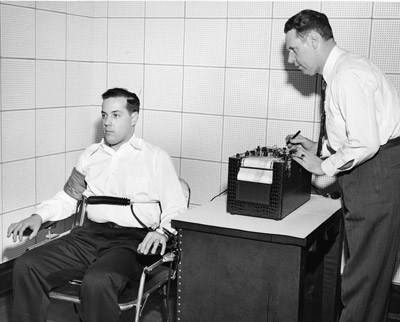Did you know…
What we call modern polygraphy—the science of truth verification based upon psychophysiological analogues—is barely 100 years old, though it’s roots go way back in time.
 In ancient China, dry rice was commonly utilized as a lie detector when trying to obtain a confession of guilt. The Chinese believed that one would stop salivating during times of emotional anxiety such as strong fear. An "examiner" would make a suspect hold a handful of dry rice in his mouth while he was asked a series of relevant questions. After questioning, the rice was examined. If it was dry, the suspect was declared to be a liar. As was assumed then—and stands true today— the nervous tension created by lying slows or blocks the flow of saliva.
In ancient China, dry rice was commonly utilized as a lie detector when trying to obtain a confession of guilt. The Chinese believed that one would stop salivating during times of emotional anxiety such as strong fear. An "examiner" would make a suspect hold a handful of dry rice in his mouth while he was asked a series of relevant questions. After questioning, the rice was examined. If it was dry, the suspect was declared to be a liar. As was assumed then—and stands true today— the nervous tension created by lying slows or blocks the flow of saliva.
 Another, more informative method of detecting deception with some psychological validity, involved a donkey. Yup—a donkey. Around 1500 BC Indian priests would dip a donkey's tail in carbon residue from an oil lamp and place the animal in a dark tent. The suspects were sent into the tent and told that pulling the "magic" donkey's tail would reveal the liar (they were allowed to assume that if a guilty man pulls the tail, the donkey will bray). When the suspects came out, the priests examined their hands. Those with clean hands had not touched the donkey's tail, so it was assumed that this was due to the suspects’ fear of their guilt being discovered, proving they were liars.
Another, more informative method of detecting deception with some psychological validity, involved a donkey. Yup—a donkey. Around 1500 BC Indian priests would dip a donkey's tail in carbon residue from an oil lamp and place the animal in a dark tent. The suspects were sent into the tent and told that pulling the "magic" donkey's tail would reveal the liar (they were allowed to assume that if a guilty man pulls the tail, the donkey will bray). When the suspects came out, the priests examined their hands. Those with clean hands had not touched the donkey's tail, so it was assumed that this was due to the suspects’ fear of their guilt being discovered, proving they were liars.
But it took till 1878, before science first came to the aid of the crime fighters through the research of Italian physiologist Angelo Mosso. He used an instrument called a plethysmograph in his research on emotion and fear in subjects undergoing questioning, and he studied the effects of these variables on their cardiovascular and respiratory activity. Mosso studied blood circulation and breathing patterns and how these changed under certain stimuli. Mosso was the first scientist to report on experiments in which he observed that a person's breathing pattern changed under certain motivations, and that this change, in turn, caused variations in their blood pressure and pulse rate.
 In 1921, John A. Larson, a Canadian psychologist employed by the Berkeley (California) Police Department, developed what many consider to be the original lie detector when he combined the measurement of both respiration rate and blood pressure. He named his instrument the polygraph—a word derived from Greek meaning many writings—since it could read several physiological responses at the same time and document these responses on a revolving drum of paper. Using his polygraph, Larson was the first person to continually and simultaneously measure changes in a subject's pulse rate, blood pressure, and respiratory rate during an interrogation. His polygraph was used extensively, and with much success, in criminal investigations.
In 1921, John A. Larson, a Canadian psychologist employed by the Berkeley (California) Police Department, developed what many consider to be the original lie detector when he combined the measurement of both respiration rate and blood pressure. He named his instrument the polygraph—a word derived from Greek meaning many writings—since it could read several physiological responses at the same time and document these responses on a revolving drum of paper. Using his polygraph, Larson was the first person to continually and simultaneously measure changes in a subject's pulse rate, blood pressure, and respiratory rate during an interrogation. His polygraph was used extensively, and with much success, in criminal investigations.
Police and People Who Stutter | Partnerships for Preparedness | Events with the Potential to Go Viral | Tribal Policing Partnerships | Solving Missing and Unidentified Persons Cases | Advancing Police Legitimacy | Did you know…?
